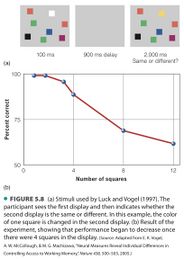Capacity Limitations Principle: Difference between revisions
Tag: Manual revert |
|||
| Line 4: | Line 4: | ||
=== Evidence === | === Evidence === | ||
The human brain can only hold a limited amount of information at any given time. Graphical or other informational displays should not require the reader to hold more than 4 perceptual groups in mind at once (Kosslyn, 2006). Recent studies about the capacity of working memory have established the capacity at around 4 items (Goldstein 2021). One experiment by Steven Luck and Edward Vogel (1997) measures the capacity of working memory by flashing two arrays of colored squares separated by a brief delay. The color of one square is changed on trails where the second array is different. The task given to participants was to determine whether the color of the square in the second array is different from the color in the first array. The result of this experiment demonstrates the participants’ performance as close to perfection when 1 to 3 squares are shown in the arrays. However, when there are 4 or more colored squares shown in the arrays, the performance of participants begins to decrease. The decline in participant performance continues as more squares are shown. From the result of this experiment, Luck and Vogel concluded that the short term memory is capable of retaining about 4 items at one time | |||
[[File:Figure 5.8.jpeg|Figure 5.8|260x260px|'''Figure 5.8''']] | [[File:Figure 5.8.jpeg|Figure 5.8|260x260px|'''Figure 5.8''']] | ||
=== Examples === | === Examples === | ||
Revision as of 22:15, 15 December 2022
Overview
The principle of capacity limitations is a concept in cognitive science that states the design of graphics and displays should take account of the limited capacity people have in their working memory and attention to retain and process information. If a message contains excessive information that exceeds people’s capacity to retain and process, it would not to be understood. This principle is commonly used in psychology and other fields to understand and explain why people may struggle with certain tasks or activities. It is based on the idea that people’s abilities are not unlimited and there are limits to what they can do. For example, a person’s working memory has a small and limited capacity, making it difficult to remember a long list of items. Due to the nature of limited capacity in people’s working memory and attention, designs of graphics and displays should contain information that does not exceed the maximum capacity to retain and process. When failing to do so, people will experience cognitive overload and fail to understand the information.
Evidence
The human brain can only hold a limited amount of information at any given time. Graphical or other informational displays should not require the reader to hold more than 4 perceptual groups in mind at once (Kosslyn, 2006). Recent studies about the capacity of working memory have established the capacity at around 4 items (Goldstein 2021). One experiment by Steven Luck and Edward Vogel (1997) measures the capacity of working memory by flashing two arrays of colored squares separated by a brief delay. The color of one square is changed on trails where the second array is different. The task given to participants was to determine whether the color of the square in the second array is different from the color in the first array. The result of this experiment demonstrates the participants’ performance as close to perfection when 1 to 3 squares are shown in the arrays. However, when there are 4 or more colored squares shown in the arrays, the performance of participants begins to decrease. The decline in participant performance continues as more squares are shown. From the result of this experiment, Luck and Vogel concluded that the short term memory is capable of retaining about 4 items at one time
Examples
Below are examples of cognitive overload taking place when the design of graphics and informational displays fails to follow The Principle of Capacity Limitations.
• https://newyork.craigslist.org/
• This image https://www.theedadvocate.org/wp-content/uploads/2018/04/DakwsobXcAA4jBM.jpg from the article 17 ways to prevent cognitive overload in your students
• This image https://cloud.netlifyusercontent.com/assets/344dbf88-fdf9-42bb-adb4-46f01eedd629/591cf336-f581-43f7-b964-5418a4f7b575/cognitive-overload-image24-large-opt.png from www.ARNGREN.net
Design Implications
It is important that graphic and contextual designs follow The Principle of Capacity Limitations and take account of the limited capacity of people’s working memory. Here are a few tips to do that:
1. Avoid putting an excessive amount of information in a single message. The quantity of information contained in one graph or display should not exceed the capacity of the working memory. Designers should avoid incorporating more than 4 items or clusters of information in one single display.
2. Chucking. Chucking refers to combining several smaller units of knowledge into a larger meaningful and relevant unit. This allows our working memory to hold more information. Incorporating the chucking method in designs allows the designer to include more information into the display without causing cognitive overload.
3. The Multimedia Principle The Multimedia Principle states that people learn better when words and pictures are presented simultaneously than from words alone. When a design incorporates The Multimedia Principle, the learners can retain and process the information displayed better and easier. This accounts for the limited capacity of the working memory and reduces the chances of cognitive overload.
References
1. Kosslyn, S. M. (2006). Graph design for the eye and mind. https://doi.org/10.1093/acprof:oso/9780195311846.001.0001
2. Goldstein, E. B. (2021). Cognitive psychology: Connecting mind, research, and everyday experience. Cengage.
3. Luck, S. J., & Vogel, E. K. (1997). The capacity of visual working memory for features and conjunctions. Nature, 390(6657), 279–281. https://doi.org/10.1038/36846

